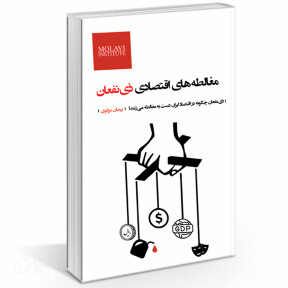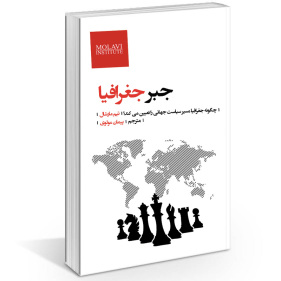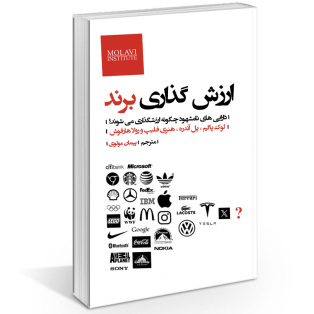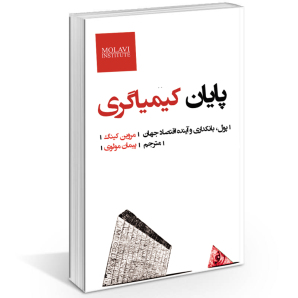The Rumi Institute was founded with the aim of promoting a scientific approach to economic issues and individual empowerment.
This non-profit institution, based on each book, creates a project to create a deep intellectual platform based on authored and translated books to take a small step towards the intellectual development of Iranians, who are the creators of Iran.
Each book has an approach to optimal and unbiased thinking.
Peyman Molavi books
Economy for everyone
How does the economy work?
Economics is the art of thinking clearly, and to see clearly, one must first have an understanding of the mechanism of that sector. In Iran, understanding the mechanism of economic movement is also important for us to recognize what will happen. In the book Economics for Everyone, you will be familiar with the basic topics of economics, perspectives, and trends, so that from now on you will not accept every word and will observe every political and economic event in a practical context and will not get too excited. This book is an attempt to make economics widespread, with a simple approach but adhering to the principles ...
Book headings:
Chapter 1: How do economists look at the world?
Chapter 2: How does the economy work?
Chapter 3: How do markets work?
Chapter 4: Economics and Business
Chapter 5: Economic Theories That Matter to Us
Chapter 6: The War of Narratives and Behavioral Economics
Chapter 7: Economic Biases That Influence Our Minds
Chapter 8: A Little History of Economic Crises
Chapter 9: Can We Make Predictions in Economics?

Dance of the Markets
How do parallel investment markets work?
What does this book say?
This book is not about policymakers, but rather a window to better see the cycles of parallel markets and the approach that each person needs to make decisions in parallel markets in Iran. I wish they had told us about investing in parallel markets when we were children, but our children are lucky that these days there is a lot of useful data and information around them from all over the world to make better economic decisions.
Book Titles:
Chapter 1: Economic Cycles
Chapter 2: Parallel Market Cycles
Chapter 3: Analytical Framework of the Iranian Economy
Chapter 4: Capital Structure and Its Role in Investment
Chapter 5: Analytical Framework of the Real Estate Market
Chapter 6: Analytical Framework of the Capital Market
Chapter 7: Analytical Framework of the Dollar
Chapter8: Analytical Framework of Gold
Chapter 9: Analytical Framework of Parallel Markets in the Iranian Economy
Chapter 10: How to Screen News with the Aim of Optimizing Investment Returns
Chapter 11: Risk Management in Parallel Markets
Chapter 12: Cognitive Errors in Investment


Stakeholder Economic Fallacies
How do stakeholders commit fallacies in the Iranian economy?
Not a day goes by in Iran that economic issues of the day are not analyzed by experts, economists, and stakeholders, and not a day goes by that decisions that appear to be expert but are actually devoid of scientific documentation are not made. This book targets 10 major, important, and frequently repeated fallacies of the Iranian economy and seeks to explain how stakeholders in an economy with an economic freedom rating of 159 (out of 165 countries in 2022) can easily align public minds with their views by having the media and communication systems, otherwise turning the issue into a completely complex and insoluble phenomenon.
Headings of this book:
Chapter 1: An Order to Mr. Economist
Chapter 2: The Eternal Fight Against Inflation
Chapter 3: Severing Iran's Relationship with the Dollar, or Dedollarization
Chapter 4: The Budget Deficit, the Cause of All Problems
Chapter 5: Hidden Subsidies and Fake Stories
Chapter 6: Not Everything Can Be Produced Domestically
Chapter 7: Does Exporting Make Us Rich or Not?
Chapter 8: Sanctions are a Blessing; Sanctions are not a Blessing
Chapter 9: Iran is an Investment Paradise
Chapter 10: Our Financial Resources Are Sufficient, It's Just Badly Managed!

The Algebra of Geography
How does geography determine the course of global politics?
Why the Algebra of Geography?
When we look at the world map at night, we see bright, dim, and dark spots, which I call the map of development without retouching.
Some spots are very bright, which are more densely populated in Europe and North America and parts of China, while some spots are dimmer, such as areas in the Middle East and parts of Africa that are completely plunged into darkness.
Sometimes in economic analyses in Iran, we hear talk that has an apocalyptic approach and is waiting for the end of everything.
The book Algebra of Geography is a refutation of common views that are interpreting the current situation by simplifying it.
This book examines natural borders, the correct concept of strategic depth, and why countries develop in the way they do. Geographical limitations are the natural weaknesses of countries, and their geographical strength distinguishes them.
This book is recommended for anyone interested in economics. Economics is the art of clear thinking, and Tim Marshall's book helps us in this regard...
Book chapters:
Chapter One: Russia
Chapter Two: China
Chapter Three: United States
Chapter Four: Western Europe
Chapter Five: Africa
Chapter Six: Middle East
Chapter Seven: India and Pakistan
Chapter Eight: Korea and Japan
Chapter Nine: Latin America
Chapter Ten: Arctic

Brand Valuation
How are intangible assets valued?
In the modern economy, where the drivers of value are shifting from tangible to intangible resources, brands are the most familiar assets. They are well-known by consumers, are perceived as an important component of a company's value, and are often the motivation for large mergers and acquisitions. However, brands are a complex intangible asset and valuing them is a difficult task that requires different expertise - legal, economic, financial, sector-specific. Using a rigorous analytical methodology from the world of modern economics and an investigation into the limitations of modern valuation techniques, this book provides empirical and theoretical background to the key topic of brand valuation. It answers many of the questions that arise when trying to value a brand. How do we understand the origin of brand value? How can we objectively assess its value? Why do some brands vary so much in valuation by consulting firms? How do we understand that some brands are valued at millions of euros when the companies that own them are making a loss?
Book headings:
Chapter 1: What is a brand?
Chapter 2: Brand Value
Chapter 3: Brand Name and Accounting Standards
Chapter 4: Surplus Income Method
Chapter 5: Income Expenditure Method
Chapter 6: Royalty Release Method
Chapter 7: Market-Based Approach
Chapter 8: Cost-Based Approach
Chapter 9: Brands and Valuation Standards
Chapter 10: Case Valuation Model
Chapter 11: Brand Value Fluctuations

The End of Alchemy
(Money, Banking, and the Future of the World Economy)
The End of Alchemy is written for a general readership and is not intended to teach economics. However, I hoped that economists would also find some of the ideas interesting. Since its initial publication in the spring of 2016, I have been pleased with the response from both groups. Slowing global economic growth, a move toward negative interest rates by a number of the world’s major central banks, growing tensions in the eurozone, and renewed concerns about the health of our banking system. In this book, Kink offers a fresh interpretation of our economic landscape and charts a new path for the global economy.
The book’s chapters:
Chapter 1: The Good, the Bad, and the Ugly
Chapter 2: The Good and the Ugly: Do We Trust Money?
Chapter 3: Innocence Lost: Alchemy and Banking
Chapter 4: Radical Uncertainty: The Purpose of Financial Markets
Chapter 5: Heroes and Villains: The Role of Central Banks
Chapter 6: Marriage and Divorce: Money and Nations
Chapter 7: Innocence Regained: Reforming Money and Banking
Chapter 8: Healing and Pride: The World Economy Today
Chapter 9: The Audacity of Pessimism: The Prisoner's Dilemma and the Coming Crisis
